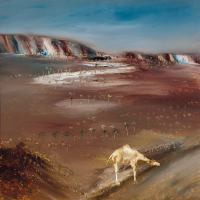30. SIDNEY NOLAN

Landscape with Camel (Burke and Wills) 1966 marks the beginning-of-the-end for the perilous Burke and Wills inland expedition of 1860-61. The Victoria Exploring Expedition was a party of nineteen men led by Robert OHara Burke and William John Wills organised to chart the inland of Australia from Melbourne to the Gulf of Carpentaria. Never reaching their destination, the journey would be marked by lapses of judgement, insubordination, and ill preparation, leaving seven men dead including Burke and Wills. Newly imported from Afghanistan and northern India, camels would be a vital addition to the cavalcade. 26 or 27 camels were employed, and many were lost, killed for food, or abandoned throughout the course of the journey. The two final camels to accompany the doomed explorers were named Landa and Rajah; recurring subjects in Nolans 1960s sequence of Burke and Wills paintings.
Nolan would revisit the Burke and Wills tragedy throughout his life from 1948 onwards, in parallel to his depictions of Australian colonial anti-hero Ned Kelly and the desert landscapes of the Australian interior and Antarctica. In the 1960s, as Nolan tracked the later stages of the expedition, iterations of Burke and Wills became more hallucinatory and increasingly frenzied and desperate in mood. The men are stripped naked, blended thinly like vapour, and posed precariously on their lanky camels; their ghostly silhouettes suggestive of despair. Nolan intuited the attrition man and camel faced and the jarring physicality of this adventure; musing I doubt that I will ever forget my emotions when first flying over Central Australia and realizing how much we painters and poets owe to our predecessors the explorers, with their frail bodies and superb will-power.1
In Landscape with Camel, Nolans brushstrokes are not as evident in the application of paint, more so the negation and movement of paint. Nolan uses a dry brush to delineate forms by scraping, thinning, and pushing the paint layer across the surface. Glimpses of a blue sky are suffocated by a soot which sweeps and lifts from the land in a foreboding manner. The composition is a simple oscillation of intimidating expanse and abrupt ridges of rock and barren slope, populated by an intervening trail of trees scrawled into the dust. Glacial blue and clean white impasto are freshly embedded in the escarpment, alleviating for a moment the homogenous swathes of rich ochre that form the landscape. The trees zigzag up and down the picture plane, inevitably to the weary camel positioned in the foreground. Nolan asks of the viewer: where are Burke and Wills?
In the context of the series, Landscape with Camel is compelling because of Burkes absence, or better yet, the presence of his absence. The scene is ambiguous, raising more questions than it answers as we confront the deserted animal. It is a moment of suspense; the question of whether the explorers are lost or, if they have already perished, cannot be answered within the painting. Instead, the missing figures are conjured as ghosts who haunt the image. The diaphanous appearance of the lone camel contributes to this evocation; it almost radiates light and seems mysteriously out of place.
The work also synthesises other motifs and inquiries developed in other series at this stage of Nolans career. This is not purely a landscape like the aerial paintings of the Central Australian Ranges or Nolans 1964 explorations of Antarctica. It isnt entirely a singular study of fauna either, where the animal comfortably occupies the land as its own (for example Great Heron 1949, private collection). And although based on an historical account, it doesnt ensure the existential certainty of Nolans 1950s Carcass compositions or present the same narrative of his Kelly series.
Painted in the same year, Camel and Figure 1966 (Tate collection, United Kingdom) and Burke and Camel 1966 (private collection) have Burke address the beholder with a semaphore-like wave tantamount to a distress signal. Accepting the reality of Burkes situation, Nolans painting elicits pathos. The situation is underscored by the hubris of Burke, who refused gifts and guidance from the Yandruwandha people in the lead up to his death. Although his selective history chose to omit the well-documented involvement of indigenous Australians during the expedition, Nolans critical view of the Burke and Wills tragedy is a poetic counterpoint to the heroism and empathy expressed in depictions by preceding artists like William Strutt (1825-1915), John Longstaff (1861-1941) and George Lambert (1873-1930).
Footnotes:
1. Sidney Nolan, quoted in Clark, J., Sidney Nolan: Landscapes & Legends, A Retrospective Exhibition: 1937-1987, National Gallery of Victoria, Melbourne, 1987, p.95
Tim Marvin
Tim Marvin is an emerging curator and art historian based in Sydney. He has a Bachelor of Art Theory (Honours, First Class) from the University of New South Wales, and currently holds positions at Sullivan + Strumpf and Artspace, Sydney.